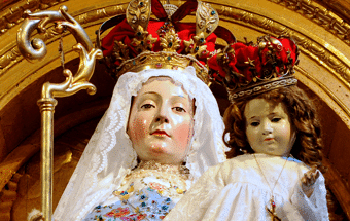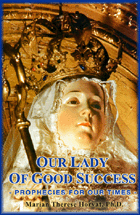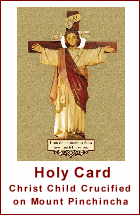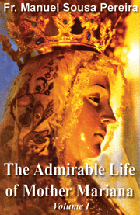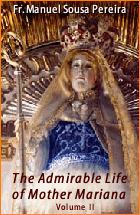Our Lady of Good Success - Questions
 |
 |
 |
 |
 |
 |
 |
Clarity on the Title of
Our Lady of Good Success
Dr. Horvat,
Please forgive me for even bringing this up for I know that you've dealt with this problem already and are tired of it being brought up. Here is the question:
Is the invocation Our Lady at Quito said as OUR LADY OF GOOD SUCCESS or Our Lady of Good Success of the Purification?
If you attached one of your articles that clears this up to an email, I would appreciate it. I know the chaos that the SSPX priests have caused in Quito and I am sorry for it.
Thank you.
God Bless you & protect you.
B.H.
Dr. Marian Horvat responds:
B.H.,
It is a pleasure to enter this topic, which has not been addressed specifically on our site, although we have dealt often with the matter of the translation (see here, here, here, here, here, here, here).
The title Our Lady of Good Success of the Purification, as you will see, can be easily clarified. It was the name Our Lady specifically wanted for this particular miraculous statue in Quito, destined to do such a great good for the whole world during the worldwide crisis in the Church and society that she predicted for our times. Unfortunately, the SSPX, as you note, is using the issue to cause confusion over the name.
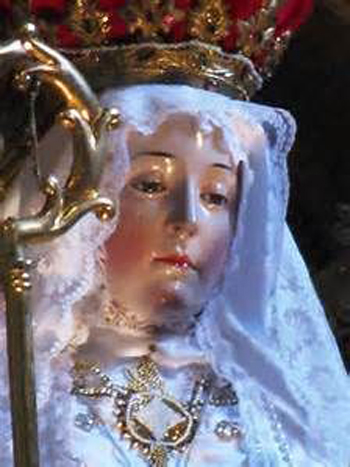 They pretend that every statue of Our Lady of Good Success is associated with the Feast of the Purification, which would be the good "Event" (buen suceso
= good event), but this is simply not the case.
They pretend that every statue of Our Lady of Good Success is associated with the Feast of the Purification, which would be the good "Event" (buen suceso
= good event), but this is simply not the case.
Let us start, then, with the question of the official name.
Most of the many statues dedicated to Our Lady under this title have no association with the Feast of the Purification. Instead, the title represented the good success Our Lady granted to the many requests made by her supplicants, especially pregnant women who asked for successful parturitions, and also of seafarers who asked for a safe journey and return to their homelands. This invocation became very popular among the mariners during the Age of Discovery and many statues were given this title, independent of the miraculous Statue of the Conceptionists in Quito, for this Statue was largely unknown by the world until the 20th century, as predicted.
The official and full title of Our Lady of Good Success in Quito is Our Lady of Good Success of the Purification, because it was on that Feast Day (February 2, 1611) that the miraculous statue was anointed with oil by the Bishop and installed in the Convent to reign as Abbess until the end of time.
It was Our Lady herself who chose this Feast Day for the statue she had commanded to be made for the Royal Monastery. In the Apparition of January 21, 1610, Our Lady told Mother Mariana de Jesús Torres that she should go to the Bishop to tell him that a statue should be made which he should consecrate with holy oil "and give the name of Mary of Good Success of the Purification, or Candlemas." (The Admirable Life of Mother Mariana, vol. 2, p. 25)
The title was known, as another Franciscan statue in Madrid - often considered the original - was called simply Our Lady of Good Success and has a completely different feast day.
Origins of the invocation
In the year 1606, two Obregonian monks discovered a small and beautiful statue in an abandoned cave in the Traiguera Mountains on their way to Rome to ask papal approval for the new habit of the Order.
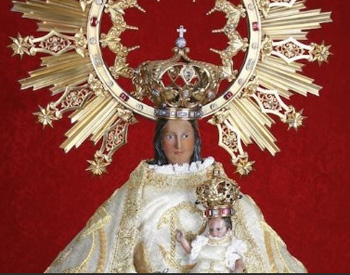 When they arrived in Rome and showed Pope Paul V the statue, he gave it the title “Our Lady of Good Success” (Italian - nostra signora di buon successo) to celebrate the good success of the friars in finding it.
When they arrived in Rome and showed Pope Paul V the statue, he gave it the title “Our Lady of Good Success” (Italian - nostra signora di buon successo) to celebrate the good success of the friars in finding it.
Upon seeing it, the Pope exclaimed, "Brothers, you have had a good success on your trip. So also you have a good success having your aspiration answered." [Hermanos, buen suceso habéis tenido en vuestro viaje. Téngalo también vuestra pretensión"]. So, he speaks of two "good successes" (not good events): the first, the finding of the statue, and the second, the granting of the papal approval they had come to request.
This title had nothing to do with the "good event" of the Feast of the Purification, which is falsely claimed by the SSPX and by the Wikipedia article that their coordinators apparently edited. (1)
Further, the feast day for the statue of Our Lady of Good Success in Madrid is not February 2 (as it is in Quito), but rather the Sunday closest to October 22, the date the statue was miraculously discovered by the Obregonian brothers.
In fact, Nuestra Señora del Buen Suceso is a name given to many statues in Spain and Hispanic America. In a book on The History of the Virgin of Good Success by Carlos Montes and Ana Maria Guirao, we find an incomplete listing of 61 statues with that title in these Spanish cities: Asturias, Albacete, Ávila, Badajoz, Barcelona, Cantabria, Catellón, Ciudad Real, Córdoba, Granada, La Coruña, Guadalajara, Jaén, León, Madrid, Málaga, Mallorca, Murcia, La Rioja, Salamanca, Segovia, Sevilla, Tenerife, Teruel, Toledo, Vizcaya, Zaragoza. Also listed are México and Ecuador.
In my brief research I have found at least a dozen more images in the Americas and the Philippines, so the count is much higher.
Some few of these churches and hermitages who honor Our Lady under this title adopted the Feast Day of February 2; most of them, like the Church in Madrid, did not, and the titles have nothing to do with an Event, such as the Purification.
A great variety of feast days
Let me offer just a few examples to demonstrate that many of the statues of Our Lady of Good Success have no association with the Feast of the Purification, purportedly the "great event" that justifies a new translation for the old title. Rather the title expresses the good success Our Lady has given to the pleas of the faithful for assistance in their spiritual and material needs.
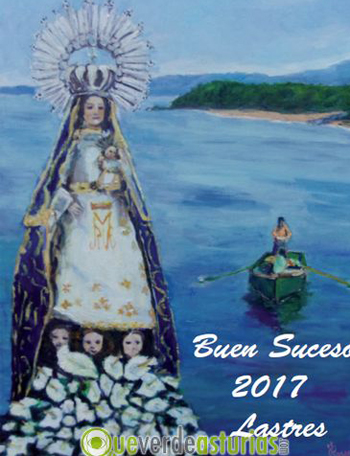 Lastres, Asturias, Spain: In the town of Lastres (officialy Llastres), the novena to the statue of Our Lady of Good Success (Nuestra Señora del Buen Suceso) begins on August 31 and ends on
September 8, her main feast day. In this charming coastal town, Our Lady of Good Success is the patroness of the fishermen, who have the long practice of turning to her to ask for her protection and good success in their seafaring ventures.
Lastres, Asturias, Spain: In the town of Lastres (officialy Llastres), the novena to the statue of Our Lady of Good Success (Nuestra Señora del Buen Suceso) begins on August 31 and ends on
September 8, her main feast day. In this charming coastal town, Our Lady of Good Success is the patroness of the fishermen, who have the long practice of turning to her to ask for her protection and good success in their seafaring ventures.
The festivities are organized by The Fishermen's Association (La Asociación de Mareantes). You can see a charming procession from 2009 here. Fishermen carry the statue through the streets on her feast day of September 8. They and their wives wear the Association's typical handkerchief scarf.
Parnañaque, Philippines: Our Lady of Good Success is the Queen of the City of Parnañaque. In 1625 an Augustinian priest Padre de Guevarra, who was keeping the image in his room, saw the statue emit marvelous lights and heard angelic hymns. The Superior General took custody of the nameless statue and asked all the friars to write titles of Our Lady on strips of paper, which he placed in an urn.
A young child drew the name "Nuestra Señora del Buen Suceso" six times. This demonstrates that by 1625 the title was already popular among the Augustinian missionaries, as well as the Franciscans.
The statue received that name and was enshrined on the altar of St. Andrew's on August 10, which became the Feast Day of Our Lady of Good Success in Parnañaque. Our Lady worked many miracles and here also, the Virgin of Good Success became the special patron of the fishermen and sailors, who went to ask her for good success in all their problems.
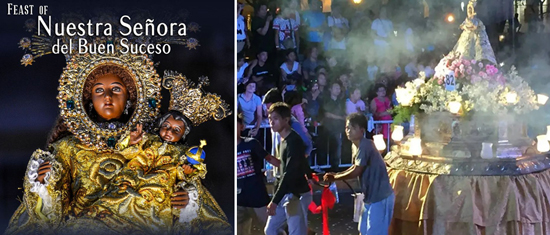 Today in Parnañaque the beloved Virgin has three Feasts: the Enthronement Feast of August 10, the Canonical Coronation anniversary on September 8 and the traditional Patron Feast of November 29, the eve of the Feast of St. Andrew. Daily processions are held each year from the 1st to 9th of September. None of the feasts, however, are celebrated on February 2 or associated with the Purification.
Today in Parnañaque the beloved Virgin has three Feasts: the Enthronement Feast of August 10, the Canonical Coronation anniversary on September 8 and the traditional Patron Feast of November 29, the eve of the Feast of St. Andrew. Daily processions are held each year from the 1st to 9th of September. None of the feasts, however, are celebrated on February 2 or associated with the Purification.
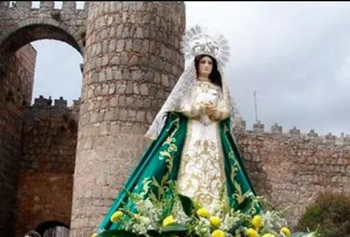 Ávila, Spain: In this ancient walled city the life-size statue of Our Lady of Good Success is carried on a large paso, or float, by red-caped men who belong to the Confraternity of that name during the Holy Week ceremonies. The statue of Our Lady of Good Success eventually meets the statue of Christ to express the first appearance of Our Lord to His Mother after the Resurrection.
Ávila, Spain: In this ancient walled city the life-size statue of Our Lady of Good Success is carried on a large paso, or float, by red-caped men who belong to the Confraternity of that name during the Holy Week ceremonies. The statue of Our Lady of Good Success eventually meets the statue of Christ to express the first appearance of Our Lord to His Mother after the Resurrection.
Fireworks sound from early morning, the bagpipes play, Our Lady's mourning veil is removed before the Statues meet, and loud cries of "Long live the Risen Christ and His Mother, Our Lady of Good Success!" mark the climax of the last procession of Holy Week. Then the Virgin is processed back to the Hermitage of Pradillo. This traditional pilgrimage always takes place on Easter Sunday, the festival day of Our Lady of Good Success.
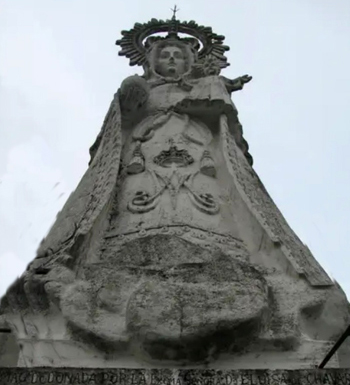 Carranza Valley, Spain: In the green Valley of Carranza, a monument dedicated to Our Lady of Good Success was erected in 1954 on the top of a mountain, offering a splendid view of the Valley. The monument honors the Virgen del Buen Suceso, the Patron Saint of the Carranza Valley since the 17th century when the Virgin appeared to a local shepherdess on September 18 and asked that she build a church in her honor under that title.
Carranza Valley, Spain: In the green Valley of Carranza, a monument dedicated to Our Lady of Good Success was erected in 1954 on the top of a mountain, offering a splendid view of the Valley. The monument honors the Virgen del Buen Suceso, the Patron Saint of the Carranza Valley since the 17th century when the Virgin appeared to a local shepherdess on September 18 and asked that she build a church in her honor under that title.
The quiet valley becomes quite lively each September 18, the feast day of the Virgin of Good Success. This day of pilgrimage, with its traditional festivities, food, dance and music, attracts thousands of residents and visitors.
Los Corrales, Seville, Spain: Each year on the first Sunday of May a singular procession is made through the streets of this town to honor the 17th century miraculous canvas painting of the Virgin of Good Success.
The town's venerated patroness, Our Lady of Good Success. is carried in procession through streets with balconies adorned with the image of the Virgin; triduums and liturgical acts are dedicated to her, rosaries are recited, and musical performances take place in the town square.
Villores, Zaragoza, Spain: The Hermitage of Our Lady of Good Success of Gelsa in the village of Villores celebrates their Patroness from September 6 to 12 with great festivity. The small hermitage was founded in 1738 and dedicated to Our Lady under this title. Her feast day on May 1 used to be an annual festival, but now is celebrated only every six years with a grand procession with great torches.
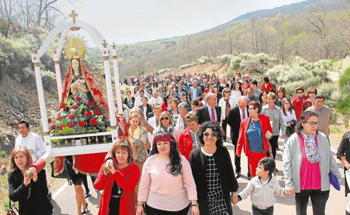 Linares de Riofrío, Salamanca, Spain: The Virgen del Buen Suceso leaves her hermitage and travels to the parish church of Linares de Riofrío in a procession through the hills to crown the Holy Week ceremonies. It is an ancient tradition that takes place each Easter Monday, which is her feast day. Accompanied by the faithful, walking to bagpipes and drums, the procession
takes place on the last day of a novena prayed to her.
Linares de Riofrío, Salamanca, Spain: The Virgen del Buen Suceso leaves her hermitage and travels to the parish church of Linares de Riofrío in a procession through the hills to crown the Holy Week ceremonies. It is an ancient tradition that takes place each Easter Monday, which is her feast day. Accompanied by the faithful, walking to bagpipes and drums, the procession
takes place on the last day of a novena prayed to her.
These are just a sampling of the many statues and images of Our Lady of Good Success with their various feast days and festivities. All of the statues I researched, save one, were not associated with the Feast of the Purification.
What happens is very simple. The people turn to the Virgin, in her goodness she hears their prayers, she grants miracles, she answers their prayers, she gives her good success.
I hope this is of some assistance to you.
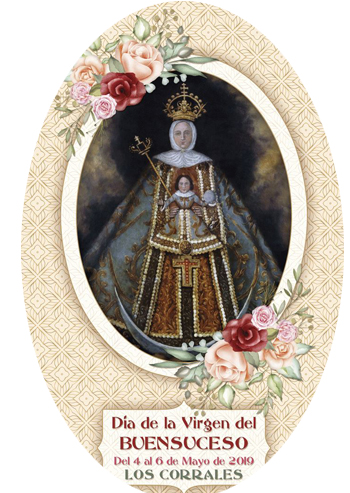

Please forgive me for even bringing this up for I know that you've dealt with this problem already and are tired of it being brought up. Here is the question:
Is the invocation Our Lady at Quito said as OUR LADY OF GOOD SUCCESS or Our Lady of Good Success of the Purification?
If you attached one of your articles that clears this up to an email, I would appreciate it. I know the chaos that the SSPX priests have caused in Quito and I am sorry for it.
Thank you.
God Bless you & protect you.
B.H.
______________________
Dr. Marian Horvat responds:
B.H.,
It is a pleasure to enter this topic, which has not been addressed specifically on our site, although we have dealt often with the matter of the translation (see here, here, here, here, here, here, here).
The title Our Lady of Good Success of the Purification, as you will see, can be easily clarified. It was the name Our Lady specifically wanted for this particular miraculous statue in Quito, destined to do such a great good for the whole world during the worldwide crisis in the Church and society that she predicted for our times. Unfortunately, the SSPX, as you note, is using the issue to cause confusion over the name.

She holds the Abbess staff & will govern the Convent
until the end of time
Let us start, then, with the question of the official name.
Most of the many statues dedicated to Our Lady under this title have no association with the Feast of the Purification. Instead, the title represented the good success Our Lady granted to the many requests made by her supplicants, especially pregnant women who asked for successful parturitions, and also of seafarers who asked for a safe journey and return to their homelands. This invocation became very popular among the mariners during the Age of Discovery and many statues were given this title, independent of the miraculous Statue of the Conceptionists in Quito, for this Statue was largely unknown by the world until the 20th century, as predicted.
The official and full title of Our Lady of Good Success in Quito is Our Lady of Good Success of the Purification, because it was on that Feast Day (February 2, 1611) that the miraculous statue was anointed with oil by the Bishop and installed in the Convent to reign as Abbess until the end of time.
It was Our Lady herself who chose this Feast Day for the statue she had commanded to be made for the Royal Monastery. In the Apparition of January 21, 1610, Our Lady told Mother Mariana de Jesús Torres that she should go to the Bishop to tell him that a statue should be made which he should consecrate with holy oil "and give the name of Mary of Good Success of the Purification, or Candlemas." (The Admirable Life of Mother Mariana, vol. 2, p. 25)
The title was known, as another Franciscan statue in Madrid - often considered the original - was called simply Our Lady of Good Success and has a completely different feast day.
Origins of the invocation
In the year 1606, two Obregonian monks discovered a small and beautiful statue in an abandoned cave in the Traiguera Mountains on their way to Rome to ask papal approval for the new habit of the Order.

The statue in Madrid, titled Our Lady of Good Success
Upon seeing it, the Pope exclaimed, "Brothers, you have had a good success on your trip. So also you have a good success having your aspiration answered." [Hermanos, buen suceso habéis tenido en vuestro viaje. Téngalo también vuestra pretensión"]. So, he speaks of two "good successes" (not good events): the first, the finding of the statue, and the second, the granting of the papal approval they had come to request.
This title had nothing to do with the "good event" of the Feast of the Purification, which is falsely claimed by the SSPX and by the Wikipedia article that their coordinators apparently edited. (1)
Further, the feast day for the statue of Our Lady of Good Success in Madrid is not February 2 (as it is in Quito), but rather the Sunday closest to October 22, the date the statue was miraculously discovered by the Obregonian brothers.
In fact, Nuestra Señora del Buen Suceso is a name given to many statues in Spain and Hispanic America. In a book on The History of the Virgin of Good Success by Carlos Montes and Ana Maria Guirao, we find an incomplete listing of 61 statues with that title in these Spanish cities: Asturias, Albacete, Ávila, Badajoz, Barcelona, Cantabria, Catellón, Ciudad Real, Córdoba, Granada, La Coruña, Guadalajara, Jaén, León, Madrid, Málaga, Mallorca, Murcia, La Rioja, Salamanca, Segovia, Sevilla, Tenerife, Teruel, Toledo, Vizcaya, Zaragoza. Also listed are México and Ecuador.
In my brief research I have found at least a dozen more images in the Americas and the Philippines, so the count is much higher.
Some few of these churches and hermitages who honor Our Lady under this title adopted the Feast Day of February 2; most of them, like the Church in Madrid, did not, and the titles have nothing to do with an Event, such as the Purification.
A great variety of feast days
Let me offer just a few examples to demonstrate that many of the statues of Our Lady of Good Success have no association with the Feast of the Purification, purportedly the "great event" that justifies a new translation for the old title. Rather the title expresses the good success Our Lady has given to the pleas of the faithful for assistance in their spiritual and material needs.

Our Lady, known & honored the good success she gives to fishermen & mariners
The festivities are organized by The Fishermen's Association (La Asociación de Mareantes). You can see a charming procession from 2009 here. Fishermen carry the statue through the streets on her feast day of September 8. They and their wives wear the Association's typical handkerchief scarf.
Parnañaque, Philippines: Our Lady of Good Success is the Queen of the City of Parnañaque. In 1625 an Augustinian priest Padre de Guevarra, who was keeping the image in his room, saw the statue emit marvelous lights and heard angelic hymns. The Superior General took custody of the nameless statue and asked all the friars to write titles of Our Lady on strips of paper, which he placed in an urn.
A young child drew the name "Nuestra Señora del Buen Suceso" six times. This demonstrates that by 1625 the title was already popular among the Augustinian missionaries, as well as the Franciscans.
The statue received that name and was enshrined on the altar of St. Andrew's on August 10, which became the Feast Day of Our Lady of Good Success in Parnañaque. Our Lady worked many miracles and here also, the Virgin of Good Success became the special patron of the fishermen and sailors, who went to ask her for good success in all their problems.

Her primary feast day in the Philippines is August 10

On Easter Sunday Our Lady of Good Success meets the statue of Christ
Fireworks sound from early morning, the bagpipes play, Our Lady's mourning veil is removed before the Statues meet, and loud cries of "Long live the Risen Christ and His Mother, Our Lady of Good Success!" mark the climax of the last procession of Holy Week. Then the Virgin is processed back to the Hermitage of Pradillo. This traditional pilgrimage always takes place on Easter Sunday, the festival day of Our Lady of Good Success.

The massive statue of Our Lady of Good Success overlooks the Valley
The quiet valley becomes quite lively each September 18, the feast day of the Virgin of Good Success. This day of pilgrimage, with its traditional festivities, food, dance and music, attracts thousands of residents and visitors.
Los Corrales, Seville, Spain: Each year on the first Sunday of May a singular procession is made through the streets of this town to honor the 17th century miraculous canvas painting of the Virgin of Good Success.
The town's venerated patroness, Our Lady of Good Success. is carried in procession through streets with balconies adorned with the image of the Virgin; triduums and liturgical acts are dedicated to her, rosaries are recited, and musical performances take place in the town square.
Villores, Zaragoza, Spain: The Hermitage of Our Lady of Good Success of Gelsa in the village of Villores celebrates their Patroness from September 6 to 12 with great festivity. The small hermitage was founded in 1738 and dedicated to Our Lady under this title. Her feast day on May 1 used to be an annual festival, but now is celebrated only every six years with a grand procession with great torches.

In Salamanca villagers on the procession on the first Sunday in May
These are just a sampling of the many statues and images of Our Lady of Good Success with their various feast days and festivities. All of the statues I researched, save one, were not associated with the Feast of the Purification.
What happens is very simple. The people turn to the Virgin, in her goodness she hears their prayers, she grants miracles, she answers their prayers, she gives her good success.
I hope this is of some assistance to you.

In Los Corrales her feast day is in the first Sunday of May

Posted March 29, 2023
______________________
______________________
- The Wikipedia posting falsely affirms that the original statue should be called Our Lady of the Good Event because "properly speaking, the phrase 'Good Event'" refers to the Purification of Mary and the Presentation of Jesus.
